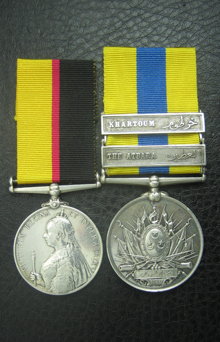
QUEEN’S SUDAN 1896-98 ‘3811 PTE. C. GIBB, 1/CAM: HDRS.’, KHEDIVE’S SUDAN 1896- 1908, 2 CLASPS, THE ATBARA, KHARTOUM ‘3811 PTE., C. GIBB 1 CAM. HIGHRS.’
Charles Gibb was born in Elgin, Morayshire, in 1878 and attested for the Cameron Highlanders at Inverness on 30 June 1896. He served with the 1st Battalion in Egypt and the Sudan from October 1897 to March 1900, and was wounded in action at the Battle of Atbara on 8 April 1898. During this battle, the Cameron Highlanders were heavily involved in the fierce hand to hand fighting when attacking the enemy trenches. The Regiment consequently suffered the brunt of the casualties that day with 44 casualties, including 3 officers killed and 1 wounded.
Gibb saw further service in South Africa during the Boer War from March 1900 to October 1902 (also entitled to the Queen’s South Africa Medal with clasps for Cape Colony, Orange Free State, Transvaal, South Africa 1901 and South Africa 1902). He transferred to the Army Reserve in June 1908, and was discharged on 29 June 1912, after 16 years’ service.
‘At sunset on 7th April 1898, the British, Egyptian and Sudanese troops of Kitchener’s army, marched out of camp, heading south towards the Zariba, the 4 infantry brigades each in a square, with the 4 British battalions leading. At around 4am the force halted on a plateau 1200 yards from the zariba.
At dawn, the army prepared for the assault on the Zariba, the brigades forming with the British on the left, MacDonald’s brigade of 3 Sudanese and 1 Egyptian battalion in the centre, and Maxwell’s Sudanese brigade on the right. The flank brigades each deployed a battalion in line, with the remaining 3 battalions following in column. The Cameron Highlanders formed the forward line for the British brigade.
In the rear, on the left, Lewis’s brigade guarded the supply camels. The Camel Corps formed a reserve in the centre. Along the line were deployed the 24 guns, the 4 maxims and the rocket detachment. The Egyptian cavalry, under Broadwood, guarded the open left flank beyond the British brigade. To the front of the attacking brigades was the line that marked the thorn fence of the Zariba. A war correspondent reported that there was a haze of dust above the Zariba, as if rifle pits and trenches were still being dug.
At 6.20am, Kitchener’s 4 artillery batteries opened fire, methodically bombarding every part of the Dervish camp. A force of Baggara horse moved out of the rear of the Zariba and made to attack the left flank of the army, but was driven back by fire from 2 of the maxims, supported by Broadwood’s cavalry. After a bombardment lasting some 75 minutes, the artillery ceased firing, and the infantry began to advance on the Zariba, halting to fire volleys into the Dervish positions.
At about 300 yards distance, the Dervish riflemen in the Zariba opened a return fire on the advancing infantry. With rising casualties, Kitchener’s battalions reached the Zariba. The Camerons, the front-line battalion of the British brigade, rushed into the camp and attacked the enemy trenches, close quarter fighting ensuing. Meanwhile the Seaforths pulled the thorn hedge aside and rushed through into the positions behind. The battalions along the line stormed through the Zariba, and engaged the Dervishes, as they emerged from their trenches and rifle pits.
In excess of 2,000 Dervish dead were found inside the Zariba. A large number of Dervishes were captured, most of whom were enlisted in Kitchener’s Sudanese battalions.
Total losses in Kitchener’s army were 80 killed and 479 wounded. During the hand to hand fighting, the leading British battalion, 1st Queen’s Own Cameron Highlanders suffered 44 casualties, including 3 officers killed and 1 wounded. The Seaforths suffered 28 casualties, including 6 officers killed and wounded. 1st Royal Warwicks suffered 11 casualties and 1st Lincolns 13 casualties. Among the non- British troops, the Sudanese battalions suffered 375 casualties, while the Egyptian battalions suffered 14 casualties.’
Condition GVF, both medals engraved in the usual Regimental style. Sold with copied research.